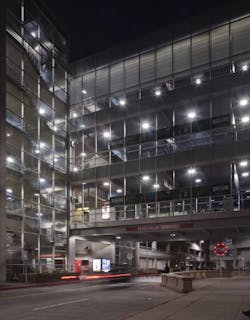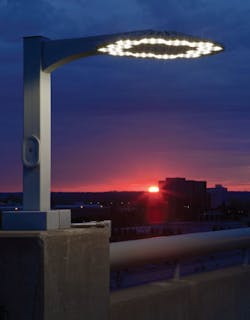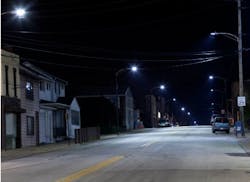Revolution on the Road: LEDs Reshape How Municipal Lighting is Sold
There’s a shift going on in the cities. You can see it in the evenings when the streetlights come on and a different, whiter, more tightly controlled illumination hints at a new way of doing business. In cities all across the United States, LED fixtures for roadway and street lighting, parking garages and parking lots are lighting up the intersection where new technology meets new sources of funds.
The change has been relatively sudden. With it has come a change in the way street and area lighting is sold. Lighting manufacturers, electrical distributors and independent reps adapting to the changes see a chance to ride a tide that already is rising fast, and will rise much faster still. There’s one major factor still to be resolved, and once that reaches its tipping point, the whole market will almost certainly see a massive storm surge of sales.The change began a few years ago, when the first blows of economic recession were being felt in city budgets. As mayors, city councils and city managers scrambled to find new ways to deal with unexpected shortfalls in tax revenues, their attention fell on the money they were paying every month to light their roads and outdoor spaces.
It was about this time that salespeople from unfamiliar companies began knocking on their doors, talking about new LED lighting systems for roads and parking lots. Some of these city officials may never have met a lighting salesman before. In most municipalities, the roadway lighting is owned by the utility and the city pays a bundled rate for power and the use of the fixtures, so for decades the key to selling roadway lighting had been to cultivate relationships with the utilities.
The claims that LED lighting could cut power consumption by half and operate for 15 years with no maintenance led the cities to consider whether it might be better to own the fixtures and pay a lower monthly rate just for the power. But the up-front cost of taking ownership of all those cobraheads and installing new LED technology is substantial. It was about that time that the federal and state governments began offering grants for infrastructure projects as part of various stimulus packages to boost activity in a lagging economy. Suddenly there was a way for cities to make the change without having to find the up-front money in their own budgets.
The resulting boom in LED lighting sales to municipalities has been dramatic, and the opportunity ahead for this market is tremendous. There are an estimated 26.5 million streetlights in the United States, according to the U.S. Department of Energy’s Municipal Solid-State Street Lighting Consortium (MSSLC). Navigant Research in a report last fall estimated that LED roadway lighting will be a $17 million business by 2020.
On the ground, manufacturers are seeing the surge first-hand. “We’re seeing major RFQs and RFPs for projects covering 500 to 50,000 units every week,” says Scott Posey, value stream manager, Infrastructure, for Acuity Brands, Atlanta. “Between the domestic U.S. and Canada, we get five to 10 a week. In the municipal space, LED has reached the tipping point.”
The established manufacturers of roadway lighting initially found themselves playing catch-up as a flood of LED-only start-ups and companies from the electronics and semiconductor industries jumped into this market, but the established players have moved quickly to protect their share, acquiring LED fixture specialists and rolling out new product lines. In a short span of time it’s changed to where you have to have LEDs to be in this market.
The technology has advanced more rapidly than just about any other market in the electrical industry, and won’t slow down anytime soon. This rate of development is expensive, which shifts some of the advantage back in favor of the large manufacturers with deep pockets.
The pace of new product introduction is closer to that of mobile phones than the historical, incremental development when roadway lighting was the domain of high-intensity discharge (HID) sources, says Mike Armstrong, product general manager for outdoor lighting at GE Lighting. “We’re already into our third generation of LED roadway products since we first got into this market in January 2010,” he says. “LED technology is advancing so quickly that systems designed now have to be adaptable to use new drivers and new technology as it becomes available. It’s all about modularity.”
The advances in LED technology are producing better street lighting with whiter light that can be controlled in ways high-pressure sodium (HPS) and other HID incumbents never could. LEDs allow system designers to tailor the light for better uniformity and to reduce light trespass into neighborhoods, for example, and it’s hard to overemphasize the importance of controls, which allow both real-time monitoring of system performance and more innovative approaches such as adjusting light levels based on traffic flow.
The shift to municipalities owning their own fixtures has dramatically changed the whole process of selling roadway lighting. It used to be a business that a rep could handle with reasonable effort, “off the side of his desk,” but those days are now gone, says Tim Hill, director of marketing and product management for the outdoor market at Eaton’s Cooper Lighting business. To start with, the number of buying influences in a typical sale has increased by orders of magnitude.
“In the utility model, you had to call on the standards engineer, the purchasing manager, maybe a business guy upstream who makes some decisions,” Hill recalls. “It was highly standardized in terms of products. When you drive down the roadway, it’s difficult for anyone not in the industry to tell whose fixture it is. It was all about price and relationships, good old-fashioned selling. Today, you still have to maintain those relationships with the utilities, because they have to allow the products on their system, but now you also have to find and cultivate relationships with the person responsible for the roadways at each city, which is sometimes an elected official, but more often an appointed position.”
The person in that position at the municipality may not have a grasp of the technology, and the technology is changing so rapidly anyway that selling in this market has become as much about education as relationships. Distributors and reps must be ready to educate new buying influences on the whole lighting system, including controls and the expanded options for shaping the lighting to fit the space, plus financial angles such as return on investment. And cultivating specifications has become a bigger issue than it has been in decades, if ever.
Specifications have become a bit of a free-for-all, say the manufacturers working in this market. Where in days past it was often the company’s independent reps who handled the RFPs, Posey of Acuity Brands says his company has brought most of that work in-house because so many ask about things that only the factory knows.
“What’s surprising is the level of detail that’s required by the end-use customer,” Posey says. “I’ve read a lot of specs over the years, and it got to the point they were pretty much boilerplate. Now requirements that come in for standard municipal lighting, the detail they require for information that’s not public knowledge — they get down to who manufactures your driver, hottest temp points, junction temperatures, LED driver, average life span. The reps don’t have the time and don’t have access to the information, in part because the product life-cycle has shortened to 10-15 months.”
The specification issue and the variability of new LED technologies has become so widespread that a number of third-party sources have stepped in to help potential buyers better compare and evaluate the options, most notably the U.S. Department of Energy. Distributors and reps operating in this market need a complete grasp of their manufacturers’ listings and ratings.
The DOE’s Municipal Solid-State Street Lighting Consortium (MSSLC) has set out to help cities avoid major disappointments. “SSL streetlights are still a relatively new development and have no long-term operating history. Therefore, substantial risk exists for making large-scale mistakes with products that are not up to the mark in terms of performance, or expected durability/lifetime in a real-world environment,” says the MSSLC’s website www1.eere.energy.gov/buildings/ssl/consortium_about.html.
MSSLC includes utilities and hundreds of municipalities that share information to help each other learn from new installations. It also publishes model specifications for roadway lighting. DOE’s Lighting Facts and CALiPER programs also help by evaluating, verifying and standardizing manufacturer claims about LED lighting, including roadway luminaires.
Another group, the DesignLights Consortium (DLC), maintains a list of qualified products that have been tested and evaluated. DLC’s Qualified Products List (QPL) has over 21,000 luminaires (all types, not just roadway and area lighting) for which representative fixtures from each product family have been independently tested. The QLP has become the standard reference for government and utility energy-efficiency programs, so for manufacturers, getting products certified and listed can be a make-or-break issue.
The Illuminating Engineering Society (IES) develops the standards to which the luminaires are tested. Its LM-79 and LM-80 (essentially testing performance and useful life, respectively) are critical factors used by buyers to evaluate and compare products.
The shift thus far has come in cities that either have their own electric utilities or work with a small, local, friendly power company that can adapt their rate structure. Large, investor-owned utilities are another matter. Their rate structures, subject to a massive regulatory approval process, usually don’t provide incentives for them to upgrade to LED technology. But it’s just a matter of time before they get on board, and when they do, watch out.
“The linchpin is when utilities ultimately figure out how this is going to play out for them and they develop rate bundles that allow for the new technology,” says Posey of Acuity. “It’s already enormous with regard to the volume. It used to be what you were selling on an annual basis was pretty much replacements, some knockdowns. What we’re seeing now is complete relight of existing space, a complete change-out. That will quadruple when the utilities jump in.”
And don’t think you can wait for this market. That surge will happen quickly, and when it tapers off, the market will be full of products that not only don’t need to be replaced, but don’t even need to be touched for 15 years. After that surge, says Posey, “If the rated lives turn out to be what they say, replacement sales will be dramatically less than they are now.”
About the Author
Doug Chandler
Senior Staff Writer
Doug has been reporting and writing on the electrical industry for Electrical Wholesaling and Electrical Marketing since 1992 and still finds the industry’s evolution and the characters who inhabit its companies endlessly fascinating. That was true even before e-commerce, LED lighting and distributed generation began to disrupt so many of the electrical industry’s traditional practices.
Doug earned a BA in English Literature from the University of Kansas after spending a few years in KU’s William Allen White School of Journalism, then deciding he absolutely did not want to be a journalist. In the company of his wife, two kids, two dogs and two cats, he spends a lot of time in the garden and the kitchen – growing food, cooking, brewing beer – and helping to run the family coffee shop.



